Segger Microcontroller Systems
| GmbH | |
| Industry | Embedded Software |
| Founded | 1992 |
| Headquarters |
Monheim am Rhein, Germany Gardner, Massachusetts USA Milpitas, California USA |
| Products | Middleware Components, JTAG Development Tools |
| Website |
segger.com, segger-us.com |
SEGGER Microcontroller is a private multinational company dealing in middleware for embedded devices as well as development and programming tools. The company was founded in 1992 and is headquartered in Monheim am Rhein, Germany with US offices in Gardner, Massachusetts and Milpitas, California.
embOS
embedded Operating System (embOS), is a Real-time operating system, developed by the Company SEGGER Microcontroller. embOS is designed to be used as a foundation for the development of embedded real-time applications for a wide range of microcontrollers.
Features
embOS is an RTOS for all embedded applications. embOS is written from scratch by the SEGGER Microcontroller company using Ansi C and assembler. Other features are:
- unlimited amount of tasks (only limited by the amount of available memory)
- preemptive scheduling with up to 232 priorities
- Round Robin with adjustable time-slices for tasks with equal priority
- adjustable time resolution (default is 1ms)
- software timers
- low power and multi-core support
- safe communication among tasks using:
- task events with up to 32 events per task
- event objects
- resource and counting semaphores
- mailboxes
- queues
- full interrupt support
- API can be called from assembly, C and C++ code
In addition to embOS, embOS-MPU offers memory protection by using the hardware's memory protection unit as well as additional software mechanisms to prevent one task from affecting the entirety of the system.
embOSView
embOSView is a tool for analysis of the running target application on an embedded system using embOS. For communication, embOSView can use UART, memory read/write for Cortex-M and RX CPUs, DCC for ARM7/9 and Cortex-A CPUs as well as ethernet. Beside system variables and software tracing, embOSView also lists all tasks with following information:
- ID: Task ID, which is the address of the task control block
- Name: Name assigned during creation
- Status: Current state of task (ready, executing, delayed, reason for suspension)
- Data: Depends on status
- Timeout: Time of next activation
- Stack: Used stack size/max. stack size/stack location
- CPU Load: Percentage CPU load caused by task
- Run Count: Number of activations since reset
- Time Slice: Round robin time slice
Field of Application
embOS is used in a variety of embedded systems in the fields of application like:
- Industrial Controls
- Internet of Things
- Networking
- Consumer electronics
- Safety critical devices
- Automotive
- Medical devices
- Avionic
Supported Devices
embOS supports all cores and compilers, e.g.:
ARM7/9/11, ARM Cortex-A/R/M, Altera NIOS2, AVR, AVR32, C16x, CR16C, ColdFire, H8, HCS12, M16C, M32C, MSP430, NIOS2, PIC18/24/32, PowerPC, R32C, R8C, RL78, RH850, RX100/200/600/700, RZ, SH2A, STM8, ST7, S08, V850, 78K0, 8051, Xtensa, ...
GCC, IAR, Keil MDK, Tasking, GreenHills, CodeWarrior, Renesas compiler CCRX, CCRL, ...
J-Link
Segger is most noted for its JTAG / SWD emulator for ARM-based microcontrollers that have ARM7 / ARM9 / ARM11, Cortex M0 / M0+ / M1 / M3 / M4 / M7 / M23 / M33, Cortex R4 / R5 / R8, Cortex A5 / A7 / A8 / A9 / A12 / A15 / A17 cores, Renesas RX, and Microchip PIC32. This device is called the J-Link.[1] It is also repackaged and sold as an OEM item[2] by Analog Devices as the mIDASLink, Atmel as the SAM-ICE, Digi International as the Digi JTAG Link, and IAR Systems as the J-Link and the J-Link KS. This is the only JTAG emulator that can add Segger's patented Flash breakpoint software to a debugger to enable the setting of multiple breakpoints in Flash while running on an ARM device which is typically hindered by the limited availability of hardware breakpoints.[3] For enhanced emulation features Segger offers a Trace Emulator, J-Trace that works with the ARM ETM interface and enables engineers to trace back their code execution.
| J-Link Model* | Host USB | Host Ethernet | Target 20-pin 0.10" | Target Other | Target ARM JTAG | Target ARM SWD | Target PIC32 ICSP | Target Max Speed | Target Max Download |
|---|---|---|---|---|---|---|---|---|---|
| PRO | Yes | Yes | Yes* | No | Yes | Yes | Yes | ||
| ULTRA+ | Yes | No | Yes* | No | Yes | Yes | Yes | ||
| PLUS | Yes | No | Yes* | No | Yes | Yes | Yes | ||
| BASE | Yes | No | Yes* | No | Yes | Yes | Yes | ||
| EDU | Yes | No | Yes* | No | Yes | Yes | Yes | ||
| Cortex-M | Yes | No | Yes* | 19-pin 0.05" | Yes | Yes | No | ||
| ARM | Yes | No | Yes* | 38-pin Mictor | Yes | No | No |
- Note: Additional models are J-Link LITE ARM, J-Link LITE CortexM, J-Link LITE RX, J-Link OB, J-Link OEM.[5]
- Note: PLUS / BASE / EDU models are physically the same hardware. The difference is license and software options, such as GDB Server, Flash Download, Unlimited Flash Breakpoints, J-Flash, RDI, RDDI. The EDU model can't be used for commercial software development.
- Note: Adapters and isolators are available to convert the 20-pin 0.1"/2.54mm male shrouded (box) header to another target board connector.[6]
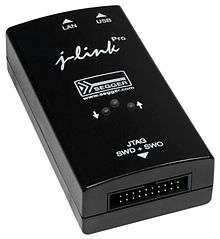
 Segger J-Link EDU: JTAG / SWD debug probe for ARM microcontrollers with USB interface to host. Low price model for educational and home users
Segger J-Link EDU: JTAG / SWD debug probe for ARM microcontrollers with USB interface to host. Low price model for educational and home users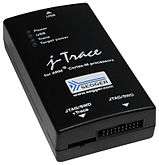 Segger J-Trace Cortex-M: JTAG / SWD debug probe and trace probe for ARM Cortex-M3 / M4 microcontrollers with USB interface to host.
Segger J-Trace Cortex-M: JTAG / SWD debug probe and trace probe for ARM Cortex-M3 / M4 microcontrollers with USB interface to host.
Flasher
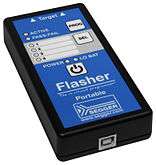 Segger Flasher Portable: Portable programmer for internal and external flash memory of ARM, PowerPC, Renesas RX microcontrollers.
Segger Flasher Portable: Portable programmer for internal and external flash memory of ARM, PowerPC, Renesas RX microcontrollers.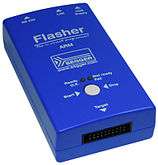 Segger Flasher ARM: Programmer for internal and external flash memory of ARM microcontrollers.
Segger Flasher ARM: Programmer for internal and external flash memory of ARM microcontrollers.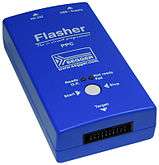 Segger Flasher PPC: Programmer for internal and external flash memory of PowerPC microcontrollers.
Segger Flasher PPC: Programmer for internal and external flash memory of PowerPC microcontrollers.
See also
References
External links
| Wikimedia Commons has media related to Segger. |